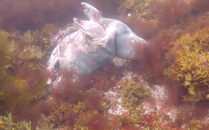We came across a dead seal on the bottom of Rachel Carson Salt Pond in Maine in about fifteen feet of water yesterday. Got me thinking about the cycle of life underwater (I don't want to break into a chorus of the Lion King or anything) but was wondering as to how long it might have been there, what time frame might it take for it to be consumed by other critters, why was it on the bottom and not floating, and why it's color was what it was.
You are using an out of date browser. It may not display this or other websites correctly.
You should upgrade or use an alternative browser.
You should upgrade or use an alternative browser.
How long?
- Thread starter icechip
- Start date
Please register or login
Welcome to ScubaBoard, the world's largest scuba diving community. Registration is not required to read the forums, but we encourage you to join. Joining has its benefits and enables you to participate in the discussions.
Benefits of registering include
- Ability to post and comment on topics and discussions.
- A Free photo gallery to share your dive photos with the world.
- You can make this box go away
Decomposition happens pretty fast underwater. Temperature is a big factor though. In warm/tropical waters, a mammalian body will begin to decompose internally (and externally). The internal bacteria will generate gasses and float the body. This can happen in the neighborhood of about 1-2 days. The body cavity will rupture and the carcass will sink again and continue to decompose (assuming the carcass doesn't wash ashore, etc.). Within a matter of days, the carcass will begin to collapse and start to become unrecognizable. In colder waters, such as you might have in Maine, this process will take longer. Depending on the temperature the process can take twice as long or even much longer. The color due in part to the lack of circulating blood, which has now pooled in the lowest part of the body. It's hard to tell from the photo, but it looks like there might be a big rupture in the body cavity. Overall, it doesn't look too decomposed though, so depending on the temperature, it could have been there for several days.
K
KeithG
Guest
I think it depends upon where you are.
On a recent trip, one of the expedition leaders found a dead seal (missing its head) floating near shore. An hour later a Polar Bear had claimed the body, dragged it to land and was busy chowing down.
The water was around +2C.
On a recent trip, one of the expedition leaders found a dead seal (missing its head) floating near shore. An hour later a Polar Bear had claimed the body, dragged it to land and was busy chowing down.
The water was around +2C.
Similar threads
- Replies
- 15
- Views
- 609
- Replies
- 13
- Views
- 943
- Replies
- 28
- Views
- 2,718
- Replies
- 7
- Views
- 597
- Replies
- 7
- Views
- 1,099




